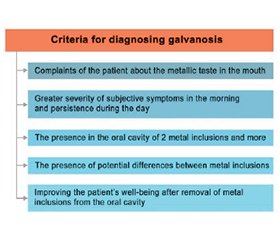Oral and General Health Том 5, №2, 2024
Вернуться к номеру
Погляд на питання етіології та патогенезу клінічних станів печіння в ротовій порожнині: актуальна проблема терапевтичної стоматології
Авторы: N.V. Hasiuk (1), I.P. Mazur (2), V.B. Radchuk (1), I.Yu. Popovych (3)
(1) - I. Horbachevsky Ternopil National Medical University, Ternopil, Ukraine
(2) - Shupyk National Healthcare University of Ukraine, Kyiv, Ukraine
(3) - Poltava State Medical University, Poltava, Ukraine
Рубрики: Стоматология
Разделы: Клинические исследования
Версия для печати
Актуальність. Питання печіння в ротовій порожнині без ушкоджень на тлі багатофакторних етіологічних чинників і клінічних проявів є складним завданням для лікарів та потребує комплексного міждисциплінарного підходу. Незважаючи на масив напрацювань, залишається актуальним питання уніфікації клінічних ознак і алгоритму обстеження для використання в практичній діяльності лікаря. Матеріали та методи. Дослідження полягає в аналізі літературних джерел на основі баз даних Scopus, Web of Science, PubMed, термін вивчення яких не перевищує 5 років, включаючи огляди літератури й результати клінічних випробувань. Результати. У роботі представлено аналітичне узагальнення клінічних критеріїв діагностики парестетичних станів слизової оболонки порожнини рота, що дозволить своєчасно та професійно діагностувати ці захворювання в повсякденній практиці лікаря-стоматолога. На першому місці при аналізі етіологічних чинників відчуття печіння в ротовій порожнині знаходиться порушення взаємодії психологічних факторів і нейрофізіологічних компонентів та дисбаланс саме вегетативної іннервації слизової оболонки порожнини рота. Висновки. Клінічні стани відчуття печіння в ротовій порожнині слід розглядати як мультидисциплінарну проблему, що потребує інтеграції лікарів різних спеціальностей.
Background. The issue of burning in the oral cavity without damage against the background of various etiological factors and clinical manifestations is a difficult task for doctors and requires an integrated interdisciplinary approach. Despite the array of developments, the issue of unification of clinical signs and the examination algorithm for use in a doctor’s practice remains relevant. Materials and methods. The research is to analyze literature sources based on Scopus, Web of Science, PubMed databases, the study of which does not exceed 5 years, including literature reviews and the results of clinical studies. Results. The work presents an analytical generalization of clinical criteria for the diagnosis of paresthetic conditions of the oral mucosa, which will allow for timely and professional diagnosis of these diseases in the daily dentist’s practice. In the first place during the analysis of etiological factors of burning sensation in the oral cavity, there is a violation of the interaction of psychological factors and neurophysiological components and an imbalance exactly of the autonomic innervation of the oral mucosa. Conclusions. Clinical conditions of burning sensations in the oral cavity should be considered as a multidisciplinary problem that requires the integration of physicians of different specialties.
глосодинія; відчуття печіння; гальваноз; ротова порожнина; слизова оболонка
glossodynia; burning sensations; galvanosis; oral cavity; mucous membrane

